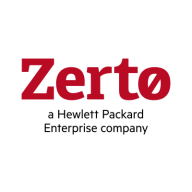

Zerto and IBM Turbonomic compete in the enterprise IT management sector. Zerto is appreciated for its pricing and support, while IBM Turbonomic leads in features, offering significant value through its extensive capabilities.
Features: Zerto specializes in business continuity and data protection with key functions like near real-time continuous disaster recovery and easy management with the ability to replicate from Hyper-V and VMware clouds. IBM Turbonomic excels at application resource management, optimizing performance using AI-driven automation, and provides comprehensive capacity and planning tools, enhancing the efficiency of resource usage across environments.
Room for Improvement: Zerto could enhance its cloud integration and automation capabilities, and further improve its user interface for better usability. It could also expand support for additional cloud platforms. IBM Turbonomic, while powerful, can benefit from simplifying its initial setup process, reducing complexity for new users, and offering more intuitive reporting features. There is also room to improve its integration capabilities with diverse cloud environments.
Ease of Deployment and Customer Service: Zerto is known for its straightforward deployment and responsive customer service, enabling faster onboarding with minimal disruption. In comparison, IBM Turbonomic also provides effective customer service and a rich set of features, though it involves a more complex setup to fully capitalize on its functionalities.
Pricing and ROI: Zerto offers cost-effective solutions primarily focused on data recovery, ensuring strong ROI through reliable service. IBM Turbonomic, though it may initially seem costlier, provides significant long-term savings by optimizing resource usage and reducing operational costs, leading to substantial ROI over time.
Before, it was a huge cost. It was several thousand dollars to do a DR test, whereas now, I click a button.
The return on investment is evident, as Zerto saves more than 60 percent of time in various operations compared to the previous manual processes.
Most people like me hope we never have to use it. It is like insurance.
I have never had an issue that was not resolved, and I have never been in a situation where they did not respond.
I would give them a rating of ten because it represents the highest level of support based on the technical knowledge of the support team, response time, and effectiveness of the provided resolutions.
We receive support around the clock, which is excellent.
I would rate it a ten out of ten for scalability.
Customers need to follow good engineering practices for optimal product use.
By adding more hosts and installing VRAs on each, tasks can be efficiently managed.
I promptly delete the malfunctioning elements and set them up again to resume replication, ensuring stability.
I consulted with tech support, and we determined the solution was to move the main workload to a resource-available ESX box.
It is 100% stable.
If I have 350 objects that I am protecting, I would like Zerto to be able to fire them up in one order, rather than having to manually bring them up in a sequence.
To increase accessibility for small and medium businesses, Zerto should consider a competitive pricing strategy, possibly including subscription-based licensing options.
The main issue with Zerto is its user interface, which lacks flexibility and presents a steep learning curve.
If you want a good-quality tool that is robust and does a good job for you, you have to pay a higher price to get that, and Zerto is no different.
However, it can become quite expensive when you start looking at the number of workloads you have in the environment and what you would like to do.
Zerto is easier to set up and use, and it's less expensive.
Zerto offers excellent technical support with responsive and helpful experts.
If we were attacked, I could revert to a backup from five seconds before the attack, and no one would know we were attacked.
The replication time and the minor amount of time it takes to sync a new server outside of any of my huge 40-terabyte boxes is ridiculously quick.


IBM Turbonomic offers automation, planning, and right-sizing recommendations to streamline resource management, improve efficiencies, and optimize costs across virtualized environments and cloud platforms.
IBM Turbonomic is valued for its capability to optimize resource allocation and monitor virtual environments efficiently. It facilitates automated decision-making in VM sizing, load balancing, and cost optimization for both on-premises and cloud deployments. Users can leverage insights for workload placement, ensure peak performance assurance, and effectively right-size across VMware and Azure. The ongoing transition to HTML5 aims to improve visual and navigational ease, while expanded reporting features are anticipated. Opportunities for improved training, documentation, and integrations enhance platform usability and functionality.
What Are the Key Features?In finance, IBM Turbonomic aids in maintaining platform efficiency during market fluctuations. Healthcare organizations leverage its capability for resource optimization during high-demand periods to enhance patient care support. Retailers use it for planning in peak seasons, ensuring resources align with fluctuating demand to maintain performance continuity.
Zerto is used for disaster recovery, business continuity, data migration, and ransomware recovery, providing continuous data protection and near real-time replication. Valued for ease of use, efficient failover processes, and versatile integration, it enhances organizational efficiency, reduces errors, and boosts productivity.
We monitor all Cloud Migration reviews to prevent fraudulent reviews and keep review quality high. We do not post reviews by company employees or direct competitors. We validate each review for authenticity via cross-reference with LinkedIn, and personal follow-up with the reviewer when necessary.